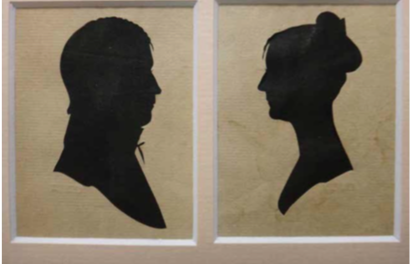(Editor’s note: DeeDee Wood is the owner of Black Cat Curiosities, an online antiques research and sales venue.)

A visitor to the Museum of Eastern Shore Life will witness relics from the past from the Queen Anne’s County area and beyond. (Photos by DeeDee Wood)
Old farm tools hang with many other antique tools in the recesses of the large Museum of Eastern Shore Life building, located at the 4-H park in Queen Anne’s County, in Centreville, Md.
Greeting me warmly were five people from the Board of Directors at the museum, who seemed very enthusiastic and excited to share information about their unique, interesting collection of Eastern Shore life.
John Harper, chairman of the board, shook my hand warmly, and along with Bonnie Roschy, treasurer, Mike Kader, publicist, Bill Lampman, manager and Carolyn MacGlashan, secretary, the group showed me around their museum and discussed the highlights and endeavors they wish to accomplish as a local non-profit.
Harper, along with the rest of the crew of people with whom I toured the facility, all have deep roots and family ties within the community they call home, and their passion for the items collected for their museum over the years — all representing Eastern Shore Life — is quite evident as they explain many of the items and their origin stories, as I peer into a vast building full of wonder.
The visitor to this large building will witness many relics from the past from the Queen Anne’s County area and beyond.
Their brochure states, “share the history of the small towns of the Eastern Shore with a visit to the Museum of Eastern Shore Life. More than a thousand artifacts and pictures from the 18th century to modern day.
Take your family on a tour covering 200-plus years of life on the Eastern Shore.”
Lampman said the museum was created by “a desire to preserve little pieces of history of the life lived on the Eastern Shore.”
While touring the exhibits within, Kader said the museum had “a complete kitchen and parlor to tour, a piano and music room, and more. These items are from the 1800s up to the 1900s, and we put them in different rooms to represent their uses and to showcase them.”
Roschy posed by a picture of a stately desk sitting in the museum with a personal story.
Her father, Robert P. Dean, was a state senator for Maryland from 1954-70, and within the museum is his desk from the Senate Chamber in Annapolis.
Bonnie said she is proud of her family’s heritage in the area.
“My father, Senator Dean, played an integral part in starting the Museum of Eastern Shore Life,” Bonnie stated.
Macglashan also posed for a picture that day, a photo with her father’s plow, situated outside the entrance to the large building.
In both of these pictures, you can feel the pride of family and history radiating off of both of these women, a link in a long chain of family history that binds this area and this museum together.
“I was born and raised here in Queen Anne’s County,” McGlashan said. “My father donated this plow to the museum.”
Chairman Harper showed me a few things that he thought really stood out in their collection in the museum.
He pointed to a long log canoe, once owned by the Brown family, utilized on a long journey on waterways from Albany, N.Y., to Church Hill, Md., via the Chesapeake Bay. Made out of a birch tree, 30 inches in diameter, it was hollowed out and saved over time by various family members.
There are informational signs explaining this and many other items in the museum.
I witnessed old, antique cars like a Model T, buggies from ages gone by, collections of encased toys, a rather impressive collection of old black and white photographs on flip boards, (talk to the museum about historic Queen Anne’s County photo copies and restoration services), vignettes of rooms of all manner, a multitude of farm tools and various tools of the Eastern Shore hanging on the walls of the museum, a diorama of stuffed song birds, (which grabbed my attention for a full five minutes), typewriters, a full print shop complete with a letterpress, “Mr. Sewell’s” blacksmith shop, and more.
Tucked into a corner there is an old switchboard, showcased with cords and multi-lines, showing pictures of the operator who once utilized this complicated machine.
There is even an extra building outside, currently under renovation, called the “Little Red House”, a relic of a homestead from the Queen Anne’s County/Centreville area.
One vignette caught my attention. It was a display of wooden tree remnants and preserved leaves off the now fallen, 400-year-old “Wye Oak Tree.”
Pictures surround the encasement, showing the mighty tree in historic photos, before it succumbed to a terrible storm in 2002.
The incredible pictures show the days gone by when it unfurled its branches in a rural area near Wye Mill, in Queen Anne’s County.
Kader indicated to me that there is a tree remnant purchase option for top-level donors to the museum, and to contact them for further information.
The Museum of Eastern Shore Life is part of the “Consortium of Historic Sites of Queen Anne’s County,” a group of historic sites in this area that includes houses, mills, museums and more.
They are all open the first Saturday of every month, with QAMESL having the hours of 1-4 p.m., on that day.
For more information about the museum, its photography collection, artifacts, Centreville or Queen Anne’s County history and more, visit the museum at 102 Dulin Clark Rd, at the 4-H Park in Centreville, visit them on Facebook at www.facebook.com/qamesl, or call them at 410-758-4729
The museum is supported, in part, by donations and membership, so consider stopping in to see this incredible collection of important Eastern Shore relics of the past, and discuss with this enthusiastic crowd how to get involved in their endeavors.




